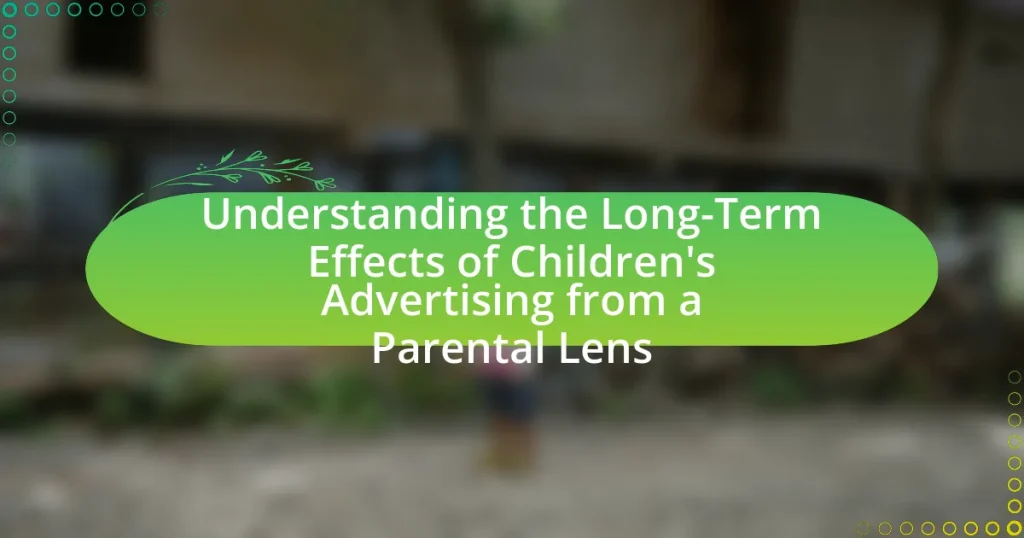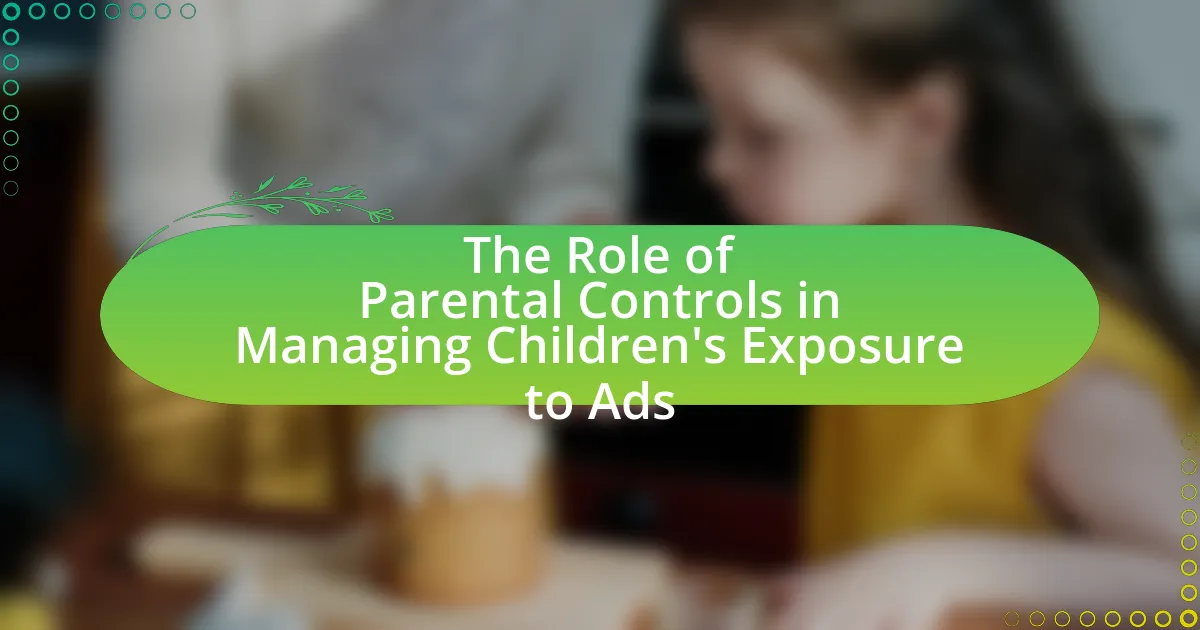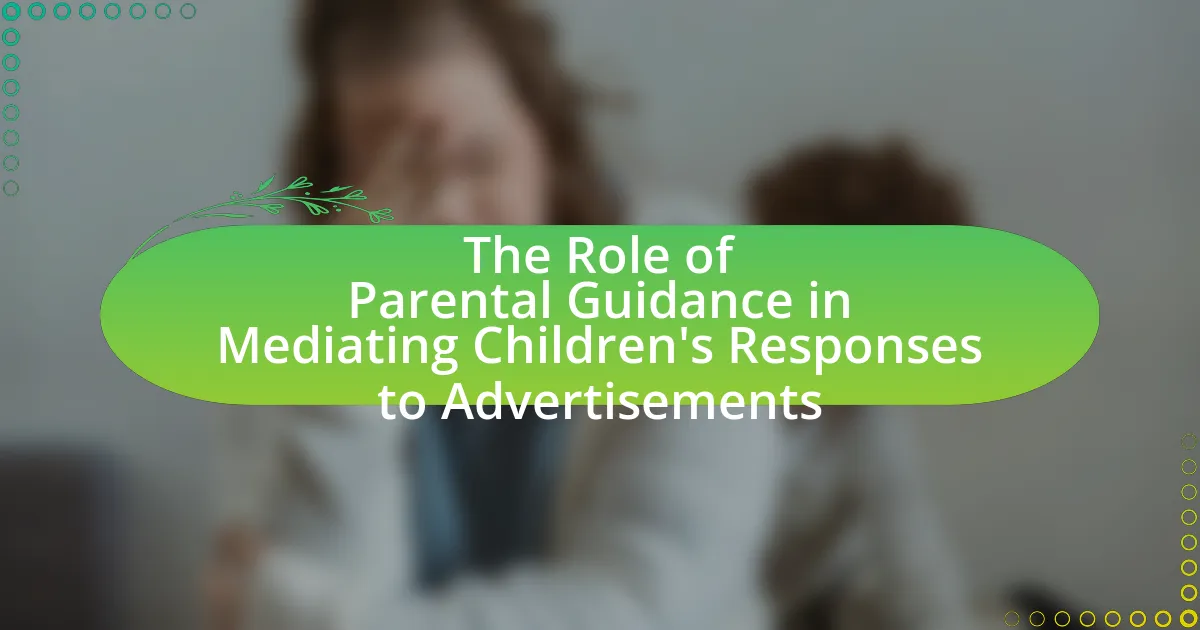The article focuses on the long-term effects of children’s advertising, emphasizing its influence on materialism, unhealthy eating habits, and brand loyalty from a young age. It highlights research findings that demonstrate how exposure to advertising shapes children’s preferences and behaviors, leading to increased consumerism and poor dietary choices. The article also explores parental perceptions of advertising, concerns regarding its impact on children’s development, and effective strategies for parents to mitigate these effects, including media literacy education and setting screen time limits. Understanding these dynamics is crucial for promoting healthier consumption habits and protecting children’s well-being.
What are the Long-Term Effects of Children’s Advertising?
The long-term effects of children’s advertising include increased materialism, unhealthy eating habits, and the development of brand loyalty at a young age. Research indicates that children exposed to advertising are more likely to prioritize material possessions and associate happiness with consumer goods. A study published in the Journal of Consumer Research found that children who frequently view advertisements are more likely to develop preferences for branded products, which can lead to lifelong brand loyalty. Additionally, exposure to food advertising has been linked to poor dietary choices, contributing to obesity and related health issues in later life. These findings underscore the significant impact that advertising can have on children’s values, behaviors, and health outcomes as they grow into adulthood.
How does children’s advertising impact children’s behavior over time?
Children’s advertising significantly influences children’s behavior over time by shaping their preferences, consumption habits, and social interactions. Research indicates that exposure to advertisements can lead to increased materialism and a desire for unhealthy food options, as children often internalize the messages conveyed in these ads. A study published in the journal “Pediatrics” found that children exposed to food advertisements were more likely to choose unhealthy snacks over healthier options, demonstrating a direct correlation between advertising exposure and dietary choices. Furthermore, longitudinal studies show that children who frequently engage with advertisements tend to develop a stronger inclination towards brand loyalty and consumerism as they grow older, impacting their purchasing decisions and social behaviors in adolescence and adulthood.
What specific behaviors are influenced by advertising?
Advertising specifically influences consumer behaviors such as purchasing decisions, brand loyalty, and product preferences. Research indicates that children exposed to advertising are more likely to request advertised products, leading to increased parental spending. A study published in the Journal of Consumer Research found that children aged 8 to 12 who viewed food advertisements were more likely to choose those products over healthier options, demonstrating a direct impact on their food choices. Additionally, advertising shapes brand perceptions, with children developing preferences for brands based on their exposure to marketing messages, which can persist into adulthood.
How do these behaviors manifest in different age groups?
Behaviors influenced by children’s advertising manifest differently across age groups. In early childhood (ages 2-5), children exhibit increased brand recognition and preference, often imitating characters from advertisements. Research indicates that children in this age range are particularly susceptible to persuasive techniques, as they lack the cognitive ability to critically evaluate advertising content.
In middle childhood (ages 6-12), children begin to understand the intent behind advertisements, leading to more complex behaviors such as requesting specific products and engaging in peer discussions about brands. Studies show that this age group develops a stronger sense of consumer identity, influenced by social interactions and advertising.
Adolescents (ages 13-18) demonstrate heightened awareness of marketing strategies and are more likely to engage in brand loyalty, often influenced by social media and peer pressure. Research highlights that teenagers are adept at recognizing advertising tactics but may still be swayed by aspirational messaging, impacting their purchasing decisions and self-image.
Overall, the manifestation of behaviors related to children’s advertising evolves with cognitive development and social influences, highlighting the need for parental guidance at each stage.
Why is it important to understand the long-term effects of children’s advertising?
Understanding the long-term effects of children’s advertising is crucial because it influences children’s consumer behavior and shapes their values and preferences over time. Research indicates that exposure to advertising at a young age can lead to materialistic attitudes and unhealthy lifestyle choices, as children may internalize the messages conveyed in advertisements. For instance, a study published in the Journal of Consumer Research found that children exposed to food advertisements are more likely to prefer unhealthy food options, which can contribute to obesity and related health issues later in life. Therefore, comprehending these long-term effects enables parents and policymakers to make informed decisions that protect children’s well-being and promote healthier consumption habits.
What are the potential risks associated with children’s advertising?
Children’s advertising poses several potential risks, including the promotion of unhealthy eating habits, materialism, and the development of unrealistic body images. Research indicates that exposure to food advertisements significantly influences children’s dietary choices, leading to increased consumption of high-calorie, low-nutrient foods (Harris et al., 2009, “Effects of Food Marketing on Children’s Eating Behaviors”). Additionally, advertisements often encourage materialistic values, which can affect children’s self-esteem and social relationships. Studies show that children exposed to idealized body images in advertising are more likely to experience body dissatisfaction and engage in unhealthy weight control behaviors (Perloff, 2014, “Social Media Effects on Young Women’s Body Image Concerns: Theoretical Perspectives and an Agenda for Research”). These risks highlight the need for careful consideration of advertising content aimed at children.
How can understanding these effects benefit parents and guardians?
Understanding the long-term effects of children’s advertising can significantly benefit parents and guardians by enabling them to make informed decisions regarding their children’s media consumption. This knowledge allows parents to critically evaluate advertisements, fostering discussions about consumerism and media literacy with their children. Research indicates that children exposed to advertising are more likely to develop materialistic values and unhealthy eating habits (Harrison & Marske, 2005). By understanding these effects, parents can implement strategies to mitigate negative influences, such as setting limits on screen time and encouraging critical thinking about marketing messages. This proactive approach not only protects children’s well-being but also promotes healthier lifestyle choices and values.
How do Parents Perceive Children’s Advertising?
Parents generally perceive children’s advertising as manipulative and potentially harmful to their children’s development. Research indicates that parents are concerned about the impact of advertising on children’s eating habits, materialism, and overall behavior. A study published in the Journal of Consumer Research found that 80% of parents believe that advertising influences their children’s food choices, leading to unhealthy eating patterns. Additionally, parents often express worries about the promotion of unrealistic body images and consumerism, which can affect children’s self-esteem and social interactions. These perceptions highlight the need for greater regulation and awareness regarding the content and methods used in children’s advertising.
What concerns do parents have regarding children’s exposure to advertising?
Parents are primarily concerned that children’s exposure to advertising can lead to unhealthy consumer habits and unrealistic expectations. Research indicates that children are particularly vulnerable to persuasive advertising techniques, which can influence their preferences and purchasing behaviors. A study published in the Journal of Consumer Research found that children exposed to advertisements are more likely to request unhealthy food options, contributing to issues like obesity. Additionally, parents worry that advertising fosters materialism and diminishes children’s ability to distinguish between needs and wants, as highlighted in a report by the American Psychological Association. These concerns underscore the potential long-term effects of advertising on children’s development and well-being.
How do these concerns vary by demographic factors?
Concerns regarding children’s advertising vary significantly by demographic factors such as age, income, education level, and cultural background. For instance, parents with higher education levels often express greater concern about the impact of advertising on children’s health and well-being, as evidenced by studies indicating that educated parents are more likely to recognize the persuasive intent of advertisements. Additionally, income levels influence concerns; lower-income parents may prioritize immediate economic benefits of advertising, while higher-income parents may focus on long-term developmental effects. Cultural background also plays a role, with parents from different ethnicities exhibiting varying levels of skepticism towards advertising, influenced by cultural values and beliefs about childhood and consumerism. These demographic variations highlight the complexity of parental concerns regarding children’s advertising and its long-term effects.
What role does parental education play in these perceptions?
Parental education significantly influences children’s perceptions of advertising. Educated parents are more likely to critically evaluate advertisements and discuss their content with their children, fostering media literacy. Research indicates that children of parents with higher education levels tend to develop a more skeptical attitude towards advertising, as these parents often emphasize critical thinking and informed decision-making. For instance, a study published in the Journal of Advertising Research found that children whose parents engaged in discussions about advertising were better equipped to discern persuasive intent, leading to healthier consumption habits.
How do parents respond to children’s advertising?
Parents typically respond to children’s advertising with concern and skepticism regarding its impact on their children’s behavior and preferences. Research indicates that many parents recognize the persuasive nature of advertisements aimed at children, leading them to actively monitor and limit their children’s exposure to such media. For instance, a study published in the Journal of Consumer Research found that 70% of parents expressed worry about the influence of advertising on their children’s food choices, prompting them to discuss advertising messages with their children to foster critical thinking. This proactive engagement reflects a broader trend where parents seek to mitigate the potential negative effects of advertising by educating their children about marketing tactics.
What strategies do parents use to mitigate advertising effects?
Parents use several strategies to mitigate the effects of advertising on their children, including active mediation, co-viewing, and promoting critical thinking. Active mediation involves parents discussing advertisements with their children, explaining the intent behind them and encouraging skepticism. Co-viewing allows parents to watch media alongside their children, providing opportunities to address misleading messages in real-time. Additionally, promoting critical thinking helps children analyze and question the content they encounter, fostering a more discerning approach to advertising. Research indicates that these strategies can significantly reduce the influence of advertising on children’s preferences and behaviors, as highlighted in studies examining parental involvement in media consumption.
How effective are these strategies in the long term?
The effectiveness of strategies aimed at mitigating the long-term effects of children’s advertising is generally limited. Research indicates that children exposed to advertising develop brand loyalty and preferences that can persist into adulthood, as evidenced by studies showing that early exposure to specific brands influences purchasing behavior later in life. For instance, a study published in the Journal of Consumer Research found that children who are frequently exposed to advertisements are more likely to exhibit brand loyalty as adults, demonstrating the lasting impact of these marketing strategies.
What Strategies Can Parents Use to Address Children’s Advertising?
Parents can address children’s advertising by implementing media literacy education, setting limits on screen time, and encouraging critical thinking about advertisements. Media literacy education helps children understand the persuasive techniques used in advertising, enabling them to recognize and question marketing messages. Research indicates that children who receive media literacy training are better equipped to analyze advertisements and make informed choices (Levine, 2018, Journal of Consumer Research). Setting limits on screen time reduces exposure to advertisements, which can decrease the likelihood of children developing materialistic values. Additionally, encouraging critical thinking allows children to discuss and evaluate the intent behind advertisements, fostering a more skeptical view of marketing. These strategies collectively empower children to navigate advertising more effectively and mitigate its potential negative impacts.
How can parents educate their children about advertising?
Parents can educate their children about advertising by discussing the purpose and techniques of advertisements. Engaging children in conversations about how ads are designed to persuade and influence their choices helps them develop critical thinking skills. For instance, parents can analyze commercials together, pointing out persuasive language, imagery, and emotional appeals used to attract attention. Research indicates that children as young as 8 years old can understand the intent behind advertising, making it crucial for parents to start these discussions early. By fostering an environment where children can question and critique advertisements, parents empower them to make informed decisions and recognize the impact of advertising on their behavior and preferences.
What resources are available for parents to teach media literacy?
Parents can access various resources to teach media literacy, including online platforms, educational organizations, and community programs. Notable resources include Common Sense Media, which offers guides and tools for evaluating media content, and the Media Literacy Now initiative, which advocates for media literacy education in schools. Additionally, the National Association for Media Literacy Education provides a framework and resources for parents to engage children in critical thinking about media. These organizations support parents in fostering skills that help children navigate and analyze media messages effectively.
How can discussions about advertising be integrated into daily life?
Discussions about advertising can be integrated into daily life by incorporating them into everyday conversations and activities, particularly during family interactions. Parents can engage children by analyzing advertisements together, discussing the persuasive techniques used, and evaluating the messages conveyed. For instance, when watching television or browsing online, parents can pause to ask questions about the intent behind an ad, fostering critical thinking. Research indicates that children exposed to discussions about advertising develop better media literacy skills, enabling them to understand and question marketing strategies (Levine, 2018, Journal of Advertising Research). This approach not only enhances awareness but also encourages children to make informed choices regarding products and brands.
What are some best practices for managing children’s media consumption?
To effectively manage children’s media consumption, parents should establish clear guidelines regarding screen time limits and content appropriateness. Research indicates that children aged 2 to 5 should have no more than one hour of high-quality programming per day, while children younger than 18 months should avoid screen time altogether, except for video chatting (American Academy of Pediatrics). Additionally, parents should co-view media with their children to facilitate discussions about content and its implications, fostering critical thinking skills. Setting a media-free time, such as during meals or before bedtime, can also promote healthier habits and improve family interactions.
How can parents set healthy boundaries around screen time?
Parents can set healthy boundaries around screen time by establishing clear rules and consistent schedules for device usage. Research indicates that children aged 2 to 5 should have no more than one hour of high-quality programming per day, while older children benefit from designated screen-free times, such as during meals and before bedtime. Additionally, parents can encourage alternative activities, such as outdoor play or reading, to promote a balanced lifestyle. By actively engaging in discussions about content and co-viewing programs, parents can also foster critical thinking about advertising and media messages, which is essential in understanding the long-term effects of children’s advertising.
What tools can parents use to monitor advertising exposure?
Parents can use various tools to monitor advertising exposure, including parental control software, ad-blocking applications, and media consumption tracking apps. Parental control software, such as Net Nanny or Qustodio, allows parents to set restrictions on content and monitor the types of advertisements their children encounter online. Ad-blocking applications like AdGuard can prevent ads from displaying on websites and apps, reducing exposure to commercial messages. Additionally, media consumption tracking apps, such as Screen Time or Family Link, provide insights into the amount of time children spend on different platforms, helping parents identify potential advertising exposure. These tools collectively empower parents to manage and limit their children’s interaction with advertisements effectively.
What practical tips can parents implement to reduce negative impacts?
Parents can implement several practical tips to reduce the negative impacts of children’s advertising. First, they should actively engage in discussions about advertisements, helping children understand the persuasive intent behind them. Research indicates that children who are taught to critically analyze ads are less likely to be influenced by them. Additionally, parents can set limits on screen time, which has been shown to decrease exposure to advertising and its associated effects. Furthermore, encouraging alternative activities, such as reading or outdoor play, can divert attention from commercial content. Lastly, parents can model healthy consumption behaviors, as children often imitate their parents’ choices, reinforcing positive habits.






